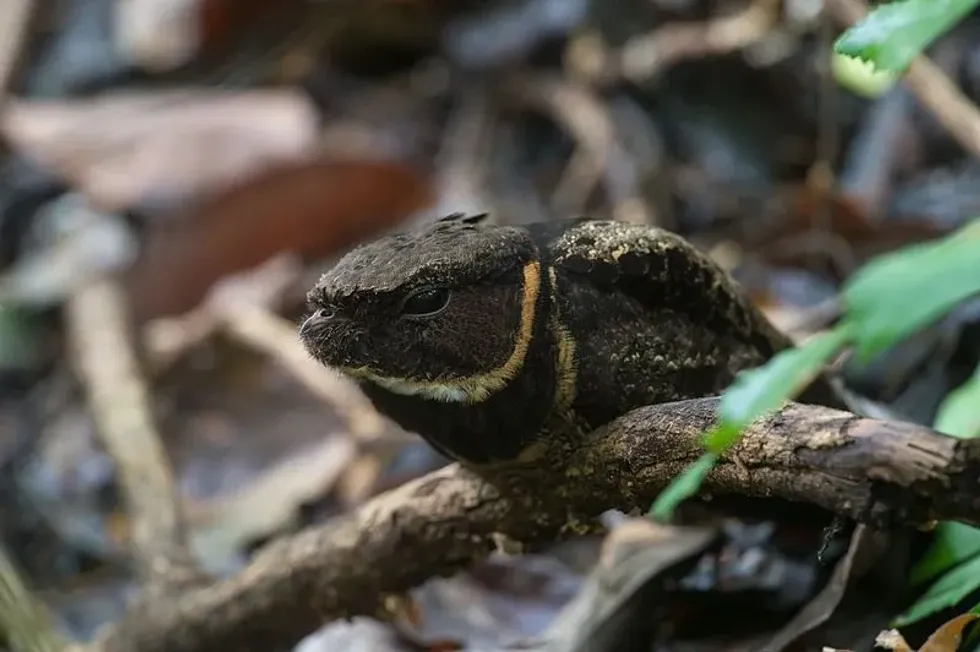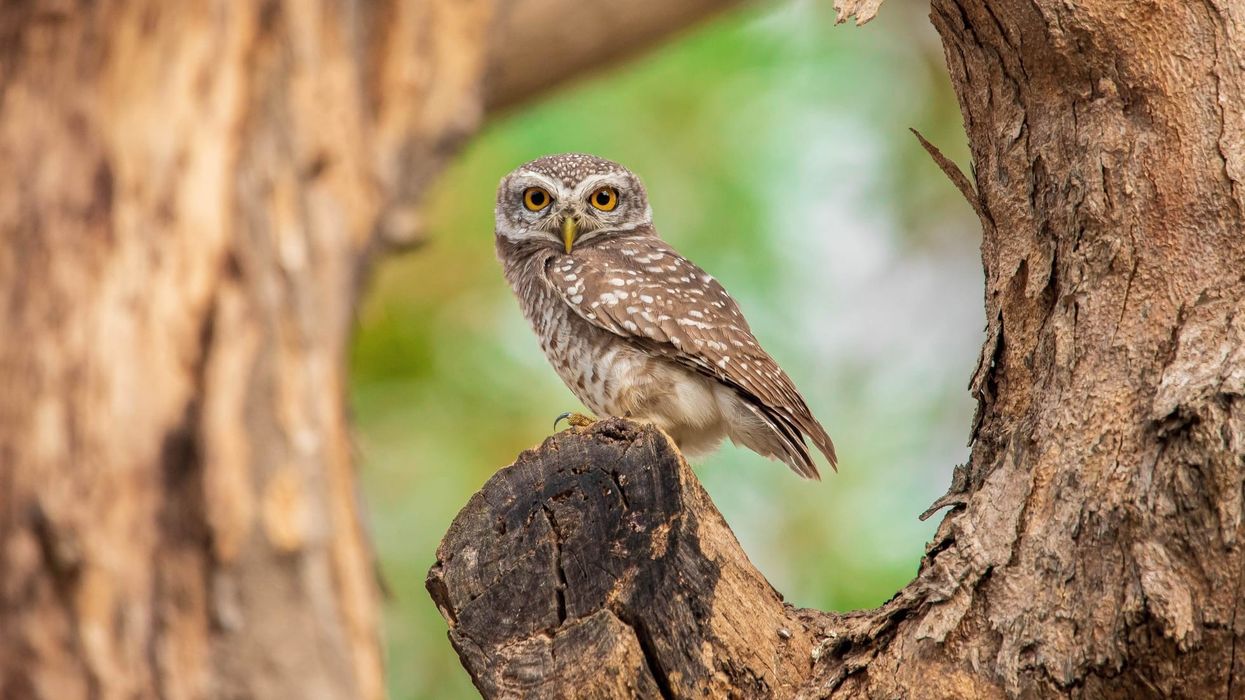The great eared nightjar (Lyncornis macrotis) is a kind of nocturnal bird found in southeast Asia. They belong to the family Caprimulgidae. This bird has five subspecies categorized under it: Lyncornis macrotis macrotis, Lyncornis macrotis cerviniceps, Lyncornis macrotis bourdilloni, Lyncornis macrotis jacobsoni, and Lyncornis macrotis macropterus.
These nightjars have tufts of feathers on their head in such a way that it looks like they have ears. The geographic range of the five subspecies of Lyncornis macrotis varies. However, their habitat type is common and includes forests, scrublands, or grasslands.
The breeding season is different in different locations. Their clutch size is one egg and the egg is incubated by both parents.
These birds are fairly common in their range and their population seems to be under no threat of endangerment. They feed on insects and are capable of catching their prey while in flight. Their calls are also quite distinct and act as a tool for identifying these birds.
To learn more about the great eared nightjar, keep reading! For more relatable content, check out these nightingale facts and night heron facts for kids.
Great Eared Nightjar Interesting Facts
What type of animal is a great eared nightjar?
The great eared nightjar, with the scientific name Lyncornis macrotis is a species of nocturnal bird, with a wide population and geographic range.
What class of animal does a great eared nightjar belong to?
The great eared nightjar (Lyncornis macrotis) belongs to the class Aves. Their order, family, and genus are Caprimulgiformes, Caprimulgidae, and Lyncornis, respectively.
How many great eared nightjars are there in the world?
The exact population of this bird species is not known. However, they have a stable trend in population and are reported to be common in their range.
Where does a great eared nightjar live?
The range of great eared nightjars (Lyncornis macrotis) includes several parts of southeast Asia. The distribution of this species varies for each subspecies. In general, these birds can be commonly seen in countries like Bangladesh, India, Malaysia, the Philippines, and Thailand to name a few.
What is a great eared nightjar's habitat?
The habitat of this species primarily comprises forests, scrublands, and grasslands. They can also be found in the forest edges and clearings. Generally, they live near rivers in such areas. Additionally, their habitat features tropical or sub-tropical climates.
Who do great eared nightjars live with?
The birds of the nightjar family are solitary in nature. The same can be assumed about the great eared nightjars. However, they do come together for breeding and incubating their eggs.
How long does a great eared nightjar live?
The exact lifespan of the great eared nightjar bird is not known. However, the lifespan of the European nightjar is 12 years. Since both belong to the same family, it can be ascertained that great eared nightjars have a similar life expectancy.
How do they reproduce?
The breeding season varies for this species based on their locations. For example, in southern India, the breeding season for this bird is from January to May. Females are known to lay only one egg. The egg is elliptical in shape and incubated by both parents.
What is their conservation status?
The conservation status of the great eared nightjar (Lyncornis macrotis) is marked as Least Concern by the International Union for Conservation of Nature or IUCN. This bird species has no known threats and appears to be fairly common.
Great Eared Nightjar Fun Facts
What do great eared nightjars look like?
The great eared nightjar or Lyncornis macrotis is a species with quite a distinct look. These birds have brown upper parts which appear speckled and spotted. These speckles and spots are grayish-white, cinnamon, or buff in color.
The underparts have buff-toned plumage with brown barred markings. Another interesting feature of this species is the tuft of feathers on their head, resembling ears. The coloration of the plumage varies depending on the subspecies.

*Please note that this is an image of a European nightjar, belonging to the same family Caprimulgidae as the great eared nightjars. If you have an image of a great eared nightjar please let us know at hello@kidadl.com.
How cute are they?
Just like lyrebirds, great eared nightjars are extremely cute birds. This species, along with all its subspecies, namely Lyncornis macrotis bourdilloni, Lyncornis macrotis jacobsoni, Lyncornis macrotis cerviniceps, and the rest, are all attractive birds with certain differences.
How do they communicate?
These birds of the order Caprimulgiformes, communicate mainly through vocalizations. The call of a Lyncornis macrotis bird sounds like a whistle resembling the 'put-wee-oo' sound. Another kind of call is a sharp 'tsik' note, which is followed up with a 'ba-haaww' tone.
How big is a great eared nightjar?
The length of a great eared nightjar (Lyncornis macrotis) bird is between 12.2-15.7 in (31–40 cm). These birds are quite larger than other species of eared nightjar of the same order Caprimulgiformes and family Caprimulgidae, known as the spotted nightjar, measuring between 9.8-11 in (25–28 cm).
How fast can a great eared nightjar fly?
The great eared nightjar has strong wings, so it can be assumed they have a fast flight as well. Additionally, they capture their prey while in flight, which further proves their efficiency. Their flight is described as being silent and gliding.
How much does a great eared nightjar weigh?
The weight of a great eared nightjar (Lyncornis macrotis) is between 4.4-5.3 oz (125–151 g). They are way bulkier than an ovenbird.
What are the male and female names of the species?
The male and female birds of this species are known as male great eared nightjars and female great eared nightjars, respectively.
What would you call a baby great eared nightjar?
A baby great eared nightjar is known as a chick.
What do they eat?
This bird is carnivorous in nature and feeds on different insects. Common insects in its diet are moths, termites, and beetles.
Are they dangerous?
There is no known information about this bird species being dangerous to humans.
Would they make a good pet?
Unlike parrots, this bird is not commonly seen as a pet. Given their nocturnal nature and eating habits, they are better suited to living in the wild.
Did you know...
A synonym for the scientific name Lyncornis macrotis of the great eared nightjar is Eurostopodus mindanensis.
The great eared nightjar's range
The range of the great eared nightjar (Lyncornis macrotis) varies depending on the subspecies. Lyncornis macrotis cerviniceps can be found in Bangladesh, northeastern India, parts of China, and so on. For the subspecies Lyncornis macrotis bourdilloni, the natural geographic range is southwestern India.
Lyncornis macrotis jacobsoni is found on Simeulue Island. The range of Lyncornis macrotis macrotis includes parts of the Philippines. Lastly, for the subspecies Lyncornis macrotis macropterus, the distribution range is Talaud Islands, Sula Islands, and so on.
The great eared nightjar's call
The great eared nightjar call is quite distinct and can be used to identify them. During flight or when perched, they give out a whistled 'put-wee-oo' sound. They also produce a sharp 'tsik' and then a 'ba-haaww' tone after a short pause. These birds become quite vocal during the breeding season.
Here at Kidadl, we have carefully created lots of interesting family-friendly animal facts for everyone to discover! For more relatable content, check out these ivory-billed woodpecker facts and belted kingfisher facts pages.
You can even occupy yourself at home by coloring in one of our free printable Great eared nightjar coloring pages.









